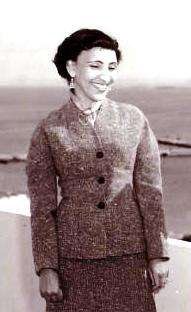Fatimah el-Sharif
| Fatimah as-Senussi | |
|---|---|
| Queen consort of Libya | |
 Queen Fatima of Libya | |
| Reign | 24 December 1951 – 1 September 1969 |
| Born |
1911 Oasis of Kufra, Italian Libya |
| Died |
3 October 2009 (aged 98) Cairo, Egypt |
| Burial | Hamza Cemetery, Medina, Saudi Arabia |
| Spouse | Idris I of Libya |
| House | Senussi |
| Father | Ahmed Sharif as-Senussi |
| Mother | Khadija[1] |
| Religion | Islam |
Sayyida Fatimah el-Sharif (Arabic: فاطمة الشريف); after marriage, Fatimah as-Senussi (فاطمة السنوسي),[2] ca. 1911 – 3 October 2009), was queen consort of King Idris of the Kingdom of Libya until the overthrow of the monarchy in 1969.
Early life
Fatimah el-Sharif was born in Italian Libya in 1911, the fifth daughter of Ahmed Sharif as-Senussi, the former chief (3rd) of the Senussi order of Sufism. Her father was active in resistance toward the colonial forces. Her mother Khadija, Ahmad Sharif's second wife, was a daughter of the influential general Ahmad al-Rifi.
In 1929, she was forced to flee on camel to Egypt from Marshall Rodolfo Graziani.
In 1931, she married her cousin Idris of Libya, then Emir of Cyrenaica and her father's successor, in Siwa Oasis. Their only son died in 1953, aged one day old.
Queenship

Upon her husband's accession as King of Libya in 1951, Fatimah became Queen. In 1954, her nephew assassinated Idris' advisor Ibrahim al-Shelhi because of a rumour that Shelhi had convinced the King to divorce Fatima in favour of a marriage with his own daughter. Idris then ordered the execution of Fatima's nephew.[3] When Idris decided to obey the demands to remarry in order to have an heir, Fatimah selected two women as prospective brides: he chose neither of them, but instead an Egyptian heir appointed by his premier, Alia Abdel Kader Lamloum,[4] whom he married in 1955. As there was no divorce, Fatimah however refused to leave the royal residence in Tobruk, and after a couple of months, she and Idris reconciled.
Post-revolution and death
Fatimah was in Turkey with her spouse at the time of Muammar Gaddafi's revolution in 1969. With the help of the Turkish government they returned from the resort town of Borsa to Kanmena Yourla in Greece. On 13 September she wrote to their lifetime friend Eric Armar Vully de Candole, CBE, who held the post of Her Britanic Majesty’s Resident, Cyrenaica: "We could not answer your cables and letters as I was alone with my husband when the coup took place without any money at all until the Turkish Government came to our help, paid our hotel and arranged our journey to Greece." She wrote to Mr. de Candole again on 26 October: "The weather here is cold and Ramadan will soon start and we cannot perform fasting obligations in any European Country. It is the will of God and may it be for the benefits of all. We shall sail next Friday for Alexandria and the same day get to Cairo."[5] She subsequently lived in Cairo from 3 November 1969 until her death.
Fatimah was later tried in absentia by the Libyan People's Court and sentenced in November 1971 to five years in prison and seizure of her assets. Her house in Tripoli was returned to her in 2007.
Fatimah died on 3 October 2009 in Cairo, aged 98. Her body was flown to Saudi Arabia for burial at Al-Baqi' in Medina beside her husband and her father accompanied by her longtime companions and servants Dr. Nafa al-Arabi al-Senussi, his wife Alia Benghalbon, and her longtime friend Amina Darbi.
Saudi Arabia denied her family permission to bury her in Al-Baqi'. Her body was finally laid to rest in the Hamza Cemetery near Mount Uhud in Medina on 7 October 2009 after salat al-Janazah in al-Masjid an-Nabawi.[6]
Personality
The relationship between Queen Fatimah and King Idris is described as a mutually happy one, and they became foster-parents to several children of relatives, as well their adopted Algerian daughter Suleima, whose father had been killed fighting against France in Algeria's war of independence.[3] Fatimah was described as humorous and tactful, with an ability to make people relax, especially children. She also was a most loyal supporter of Idris, with a simple but elegant style. Fatimah also became a role model for a new way of life for the women of Libya by her role as a queen.[3] Fatimah neither wore a veil, nor did she live in seclusion; as a queen, she played a visible role in society, and was present regularly at various public events.[3]
Ancestry
| Ancestors of Fatimah el-Sharif | ||||||||||||||||||||||||||||||||||||||||||||||||||||||||||||||||||||||||||||||||||||||||||||||||||||||||||||||||||||||||||||||||||||||||||||||||||||||||||||||||||||||||||||||||||||||||||||||||||||||||||||||||||||||||||||||||
|---|---|---|---|---|---|---|---|---|---|---|---|---|---|---|---|---|---|---|---|---|---|---|---|---|---|---|---|---|---|---|---|---|---|---|---|---|---|---|---|---|---|---|---|---|---|---|---|---|---|---|---|---|---|---|---|---|---|---|---|---|---|---|---|---|---|---|---|---|---|---|---|---|---|---|---|---|---|---|---|---|---|---|---|---|---|---|---|---|---|---|---|---|---|---|---|---|---|---|---|---|---|---|---|---|---|---|---|---|---|---|---|---|---|---|---|---|---|---|---|---|---|---|---|---|---|---|---|---|---|---|---|---|---|---|---|---|---|---|---|---|---|---|---|---|---|---|---|---|---|---|---|---|---|---|---|---|---|---|---|---|---|---|---|---|---|---|---|---|---|---|---|---|---|---|---|---|---|---|---|---|---|---|---|---|---|---|---|---|---|---|---|---|---|---|---|---|---|---|---|---|---|---|---|---|---|---|---|---|---|---|---|---|---|---|---|---|---|---|---|---|---|---|---|---|
| ||||||||||||||||||||||||||||||||||||||||||||||||||||||||||||||||||||||||||||||||||||||||||||||||||||||||||||||||||||||||||||||||||||||||||||||||||||||||||||||||||||||||||||||||||||||||||||||||||||||||||||||||||||||||||||||||
References
External links
![]() Media related to Fatimah el-Sharif at Wikimedia Commons
Media related to Fatimah el-Sharif at Wikimedia Commons
| Fatimah el-Sharif Senussi dynasty Born: 1911 Died: 3 October 2009 | ||
| Regnal titles | ||
|---|---|---|
| New title New state created |
Queen consort of Libya 24 December 1951 – 1 September 1969 |
Vacant |